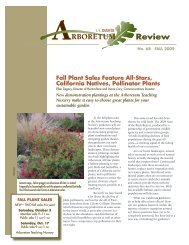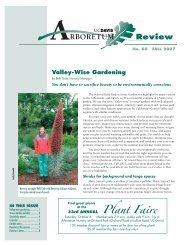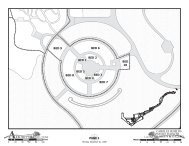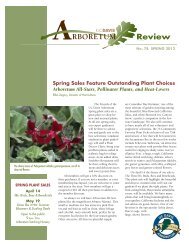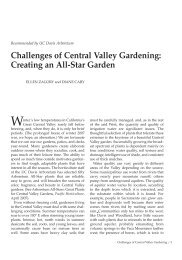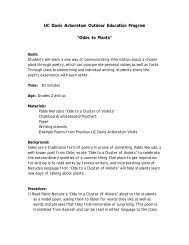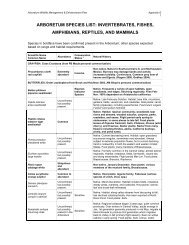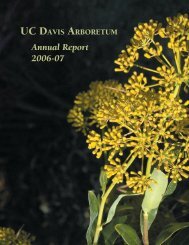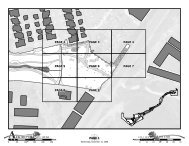All-Stars wildlife brochure.indd - the UC Davis Arboretum
All-Stars wildlife brochure.indd - the UC Davis Arboretum
All-Stars wildlife brochure.indd - the UC Davis Arboretum
Create successful ePaper yourself
Turn your PDF publications into a flip-book with our unique Google optimized e-Paper software.
WHY PLANT FOR<br />
WILDLIFE?<br />
As development spreads out from California’s<br />
urban centers, more and more wildlands are<br />
converted to housing and industrial uses.<br />
It’s hard for animals to survive when <strong>the</strong>ir<br />
food sources and shelter disappear. Home<br />
gardeners can provide a refuge that supports<br />
local populations of birds and insects and<br />
helps <strong>the</strong>m continue <strong>the</strong>ir ancient patterns<br />
of migration. As an added bonus, <strong>the</strong>y will<br />
pollinate your plants and add sound and<br />
motion to your garden.<br />
POLLINATORS & FLOWERS:<br />
CO-EVOLUTION<br />
Flowers attract pollinators in amazing ways.<br />
Some fl owers have evolved special colors or<br />
produce odors; o<strong>the</strong>rs provide nectar that only<br />
specialized mouth parts can reach. Insect<br />
pollinators are <strong>the</strong> most common, easily<br />
observable on warm days:<br />
• Beetles visit large fl owers with lots of pollen.<br />
• Bees prefer fl owers with landing pads that<br />
refl ect light in <strong>the</strong> ultra-violet range.<br />
• Moths zig-zag <strong>the</strong>ir way through evening<br />
scents to pale fl owers whose fragrance acts<br />
as a beacon.<br />
• Butterfl ies sip nectar from fl owers with <strong>the</strong>ir<br />
long, coiled mouth parts.<br />
In <strong>the</strong> Central Valley, hummingbirds are agents<br />
of pollination. Hummingbirds prefer long,<br />
tubular fl owers that fi t <strong>the</strong>ir slender beaks.<br />
They are especially attracted to red fl owers.<br />
HOW TO ENCOURAGE BIRDS &<br />
INSECTS TO VISIT YOUR GARDEN<br />
• Choose plants that animals use for food and shelter<br />
(see list on back).<br />
• Use a variety of plants that bloom in sequence over<br />
<strong>the</strong> course of <strong>the</strong> year.<br />
• Select plants that grow to different heights and<br />
widths to provide many locations for birds to feed<br />
and build <strong>the</strong>ir nests.<br />
• Use plants that produce silken fi bers to provide<br />
nesting materials.<br />
• Create perches from bare branches for birds to rest<br />
on.<br />
• Provide a water source—a fountain, pool, or<br />
birdbath.<br />
BENEFICIAL INSECTS<br />
FOR PEST CONTROL<br />
You can choose plants for your garden that attract<br />
benefi cial insects—those that prey on insect pests. For<br />
example, syrphid fl ies are common benefi cial insects that<br />
eat aphids. The adults look like small bees, although <strong>the</strong>y<br />
are really fl ies. They hover in <strong>the</strong> air and need nectar<br />
and pollen plants on which to lay <strong>the</strong>ir eggs. The legless<br />
larvae can often be seen on roses dining on aphids.<br />
A NOTE OF CAUTION<br />
While butterfl ies are nectar-sippers, caterpillars are<br />
voracious eaters and can strip <strong>the</strong> leaves off <strong>the</strong>ir<br />
favorite plants. Plant <strong>the</strong> nectar sources in <strong>the</strong> front<br />
of <strong>the</strong> garden and <strong>the</strong> larval food plants in an inconspicuous<br />
place in <strong>the</strong> back. Also, remember that cats<br />
might discourage nesting or kill young birds.<br />
HOW TO<br />
ATTRACT<br />
WILDLIFE<br />
TO YOUR<br />
CENTRAL VALLEY<br />
GARDEN<br />
PROTECT native plants by<br />
supporting <strong>the</strong> pollinators<br />
<strong>the</strong>y depend on<br />
ENJOY <strong>the</strong> sight and sound<br />
of birds and butterfl ies in <strong>the</strong><br />
garden<br />
HELP combat habitat loss by<br />
making your garden a <strong>wildlife</strong><br />
refuge<br />
<br />
GREAT PLANTS FOR CENTRAL VALLEY GARDENS





